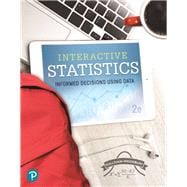NOTE: Before purchasing, check with your instructor to ensure you select the correct ISBN. Several versions of the MyLab™ and Mastering™ platforms exist for each title, and registrations are not transferable. To register for and use MyLab or Mastering, you may also need a Course ID, which your instructor will provide.
Used books, rentals, and purchases made outside of Pearson
If purchasing or renting from companies other than Pearson, the access codes for the MyLab platform may not be included, may be incorrect, or may be previously redeemed. Check with the seller before completing your purchase.
For courses in Introductory Statistics.
This package includes MyLab Statistics.
Go INTERACTIVE with Sullivan/Woodbury’s Interactive Statistics
Interactive Statistics: Informed Decisions Using Data presents content in a way that gets students actively doing statistics as they learn new concepts. Written entirely in MyLab™ Statistics, Interactive Statistics engages students by combining text, multimedia, and assessment into one seamless learning experience: Interactive Assignments. Through a series of Interactive Assignments, students are encouraged to experience statistics in new and dynamic ways.
Authors Mike Sullivan and George Woodbury are both active in the classroom, and they incorporate ideas and strategies from their experience teaching today’s students. Their practical approach paired with the interactive, guided learning environment helps improve students’ conceptual understanding, knowledge retention, and ability to see how statistics is connected to the world at large.
Personalize learning with MyLab Statistics
By combining trusted author content with digital tools and a flexible platform, MyLab personalizes the learning experience and improves results for each student. With MyLab Statistics and StatCrunch, an integrated web-based statistical software program, students learn the skills they need to interact with data in the real world.
0134673522 / 9780134673523 Interactive Statistics: Informed Decisions Using Data Student Access Kit, 2/e












